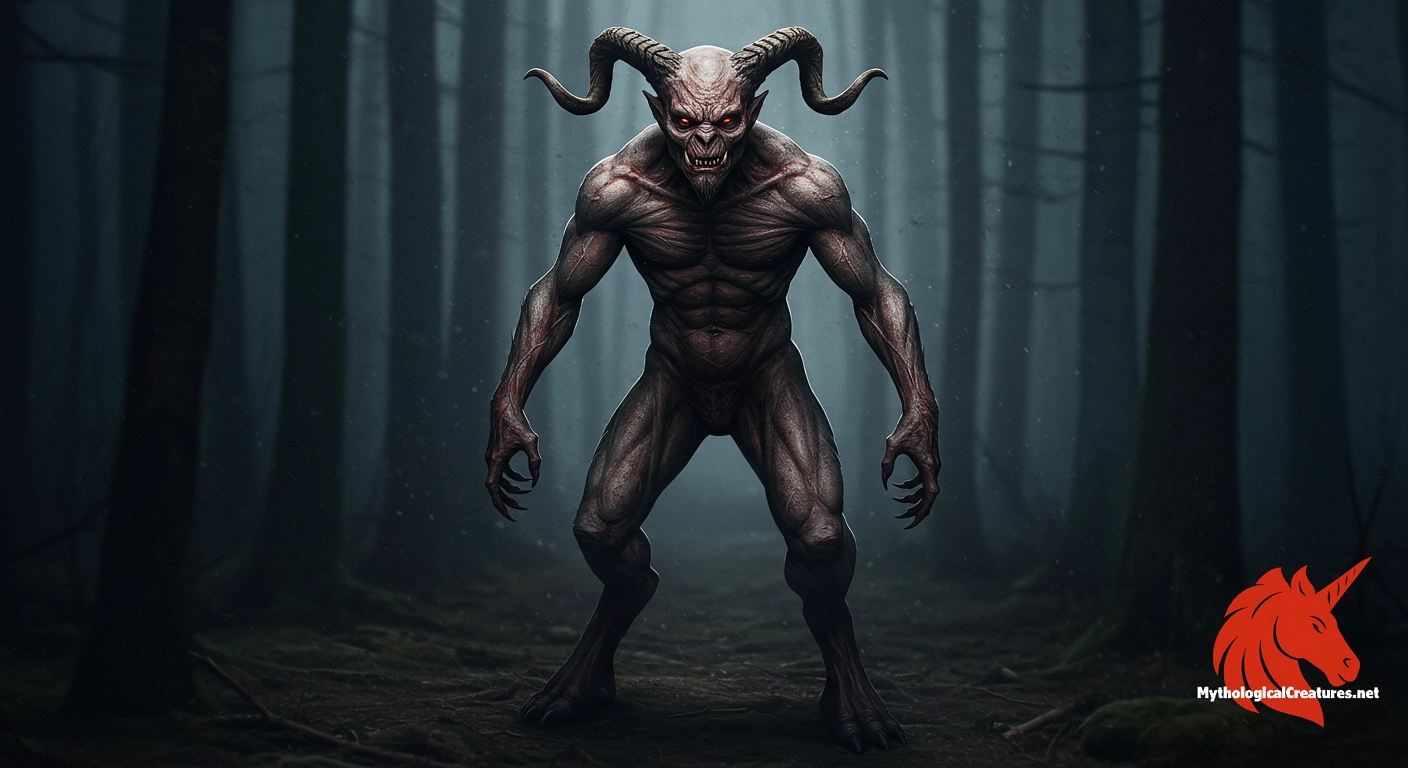Bies: Bies is an evil spirit or demon from Slavic mythology, often identified with the devil.

Bies
Bies - Represents malevolent forces and the merging of pagan and Christian demonology in Slavic mythology.
Origins & First Encounters
The Bies is a notorious spirit that occupies a pivotal role in the rich tapestry of Slavic mythology, embodying an aura of malevolence and primordial chaos. Emerging from ancient, pre-Christian traditions, this demon was originally perceived as a mysterious force that straddled the line between nature’s wrath and a supernatural curse. Its earliest mentions, embedded in folk narratives, attest to a creature feared for its unpredictable and often destructive presence. Over time, as Christian doctrines began to permeate Slavic lands, the Bies was increasingly assimilated into the broader narrative of devilry, often being conflated with figures such as the chort or czort. With the passage of centuries, linguistic variations emerged—Bies in Polish, Bes in Russian and other Slavic tongues, and Bijes in Bosnian and Croatian—each variant deepening the creature’s mythological resonance. The spirit’s cultural imprint is evident in ritualistic warnings, moral legends, and even common expressions that evoke the simmering forces of uncontrollable anger. Its enduring allure lies in its duality: a being capable of both inciting terror and symbolising the wild, untameable aspects of nature. Intricate and multifaceted, the Bies continues to stand as a testament to the Slavic people’s attempt to personify the darker recesses of human emotion and natural disorder. In the modern imagination, this ancient demon remains a powerful emblem of the struggle between order and chaos.
Source Texts & Tale Variants
The earliest textual references to the Bies are found in a blend of medieval manuscripts, folk tales, and early church writings that sought to encapsulate the enigmatic qualities of this spirit. Various sources, written in different Slavic languages, reveal a shifting portrayal of the demonic figure as it moved from pagan veneration to a more explicitly Christian embodiment of evil. In some religious texts, the term Bies is used almost interchangeably with the devil, reflecting how oral traditions and doctrinal reinterpretations merged over time. There exist a number of intriguing narrative variants where the creature not only inflicts misfortune but also interacts with humans through possession stories and ominous warnings. A notable instance is its appearance in biblical translations, as seen in the Russian usage of the plural biesy in scriptural contexts such as the exorcism narratives. Folk tales have also narrated encounters where the creature’s influence precipitates madness or wild, uncontrollable fury among its victims. These narratives underscore a fluidity in identity, with each retelling adapting the Bies to local moral lessons and societal anxieties. The myriad versions found in primary sources reveal a compelling evolution from a fearsome natural spirit to a symbol of diabolical retribution that transcends simple categorisation. As a result, the primary literary and oral accounts offer a layered understanding of the Bies’s role in societal and religious discourse.
Form & Powers
The physical appearance of the Bies is as elusive and varied as the stories that describe it, with accounts painting it in strikingly grotesque and otherworldly terms. It is frequently depicted with a contorted, almost feral visage, often accentuated by features that blend animalistic and humanoid elements in a disquieting manner. Imagery of twisted horns, reminiscent of a ram or goat, appears in some depictions, emphasising its connection to untamed nature and wild impulses. Eyes that gleam with a baleful light and a mouth capable of conveying both silent malice and ferocious anger are recurrent traits in the descriptions of this spirit. Observers have noted the creature’s limb proportions to be unsettlingly asymmetrical, with spindly arms and clawed hands that proffer an air of relentless menace. Variations in its size also abound, suggesting that the Bies can manifest as either a diminutive, shadowy spectre or an overwhelmingly imposing presence. In certain folk renditions, the creature is even described as being enveloped in tattered, dark vestments that flow like midnight fog, enhancing its spectral allure. This merging of human and bestial attributes not only underscores the Bies’s ambiguous nature but also contributes to its lasting impact on artistic and cultural imaginations. The vivid, ever-changing imagery associated with the Bies continues to captivate those who encounter its depictions in both historical art and modern reinterpretations.
Regional Faces
Across the diverse landscapes of the Slavic world, the characterisation of the Bies undergoes significant regional adaptation, reflecting the cultural and linguistic plurality of the area. In Polish tradition, it retains the appellation Bies, while in Russian folklore the variant Bes often signifies not just a demon but also connotes a broader sense of uncontrollable wrath. In the South Slavic traditions, particularly among Bosnian and Croatian speakers, the term Bijes intriguingly doubles as a descriptor for intense rage or fury, blending the supernatural with everyday emotional expression. These regional variations extend beyond nomenclature, influencing the creature’s attributed powers, roles in local legends, and even its physical depiction. In some areas, the Bies is portrayed as a relentless tormentor in tales of personal misfortune, whereas in others it assumes a more ambivalent persona, embodying the natural forces of wild anger. Local myths have integrated the creature into cautionary tales that warn against moral decay and the perils of uncontrolled emotion. This adaptability has allowed the Bies to traverse geographical and cultural boundaries while remaining a significant symbol of menacing power. Consequently, each regional interpretation contributes distinct narrative layers that speak to the underlying human desire to make sense of chaos and moral transgression.
Cultural Parallels
Exploring the nature of the Bies reveals compelling parallels with a range of demonic entities found in both ancient and modern mythologies. Its transformation under the influence of Christianity invites comparison with the Greek concept of the daimon, which similarly straddles the line between a morally ambiguous spirit and an outright embodiment of evil. This process of cultural reinterpretation is not unique to the Bies; similar figures, such as the chort in Slavic lore, share many attributes, further blurring the lines between folklore and religious demonology. The Bies, much like other infernal beings, embodies the human need to externalise internal fears and ungovernable passions. In various European traditions, especially those of Nordic or Mediterranean origin, spirits akin to the Bies serve as cautionary figures whose existence warns of the chaos lurking beneath civilisation. Such comparisons extend to the modern-day usage of terms derived from the creature’s name to describe states of uncontrolled fury or madness. By analysing these cultural parallels, one can trace how mythmakers have consistently repurposed the image of the demonic to suit the evolving moral and psychological landscapes of their societies. Ultimately, the Bies serves as a bridge linking an array of mythological traditions, highlighting the universality of themes related to temptation, retribution, and the struggle against inner demons. This synthesis of influences enriches our understanding of how different cultures conceptualise the forces of evil and chaos.
Legacy & Modern Evolution
The historical evolution of the Bies is a fascinating chronicle of cultural transformation, reflecting shifts from early pagan rites to established religious dogma and modern pop-cultural reinterpretations. Originally envisioned as a mysterious and fearsome spirit, the Bies was reconfigured through centuries of Christian influence, ultimately being subsumed into the iconography of the devil. This metamorphosis not only altered its narrative function but also reshaped its symbolic significance, turning it into a cautionary emblem of moral decay and existential dread. Over the ages, the creature has appeared in various forms across literature, art, and oral traditions, each iteration maintaining a connection to the primordial notions of chaos and fury. In modern portrayals, the Bies is sometimes shown as an enigmatic force that mirrors contemporary concerns about human vulnerability and the loss of control. Its enduring legacy is further evidenced by its influence on modern language, where derivatives of its name convey a sense of wild, uncontrollable anger. Present-day interpretations in films, graphic novels, and video games have reimagined the creature in diverse and innovative ways that both honour and reinterpret ancient myth. As a cultural artefact, the Bies now serves as a nexus between the archaic, supernatural world and modern narratives of psychological horror, thereby perpetuating its legacy as a symbol of the eternal struggle between order and chaos.
Interesting Fact
Bies not only influenced demonic nomenclature in Slavic folklore but also lent its name to common expressions for irrational fury, illustrating the deep interconnection between myth and language.
Quick Creature Info
Our Mythic Legendary Rating:

Also Sometimes Known As:
Habitat:
Supernatural Powers:
Abilities:
Behavior:
Weaknesses:
Lore:
References
Discover Another Mythical Legend You May Not Have Heard Of?
Uncover the mysteries of ancient folklore and expand your knowledge of legendary beings from cultures around the world.
Dare to Meet the Zhong Kui....
Mythical Disclaimer: The images and data on this site are derived from various historical and literary sources, but we have found that many myths often have multiple versions and interpretations across references, sometimes contradictory. As a result, these creature depictions are artistic interpretations—imaginative blends of folklore, legend, and a dash of AI guesswork. Because creature descriptions vary widely, our illustrations and accompanying information represent our best effort to honor mythology while bridging creative gaps. Enjoy these interpretations—just remember, we've done our best to respect the stories and validate available data, but in the realm of mythology, details often shift, imagination leads the way, and nothing is ever set in stone!
Curated by the Mythological Creatures Team (rev. May 2025)
